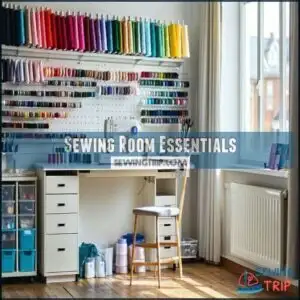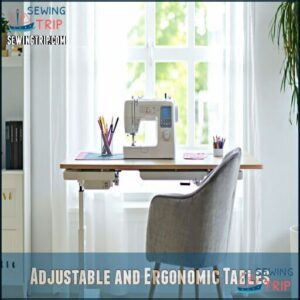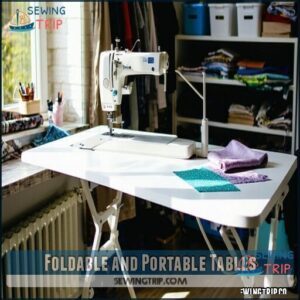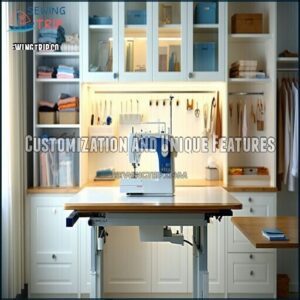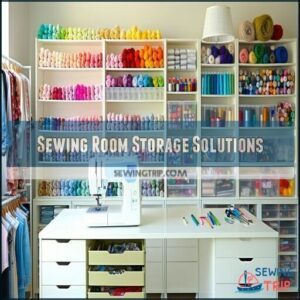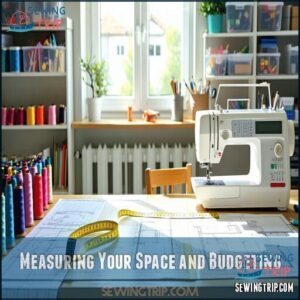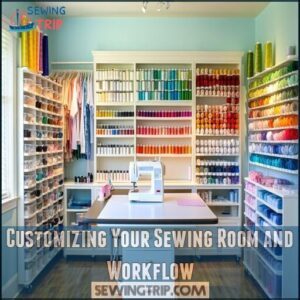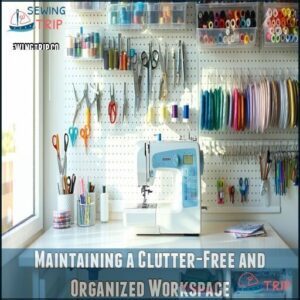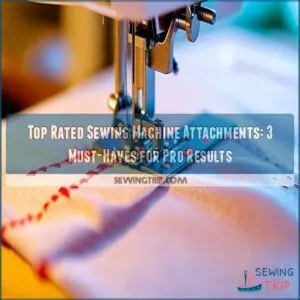This site is supported by our readers. We may earn a commission, at no cost to you, if you purchase through links.

Table Of Contents
- Key Takeaways
- Sewing Room Essentials
- Top 10 Sewing Room Furniture
- 1. White Craft Table Pantry Cabinets Sauder
- 2. Glacier White Craft Sewing Armoire
- 3. Compact Portable Folding Sewing Table
- 4. White Farmhouse Craft Table on Wheels
- 5. Folding Sewing Craft Table with Storage
- 6. Crafit Sewing Table Craft Storage
- 7. IRIS USA 44 Drawer Organizer
- 8. DWVO Folding Sewing Craft Table White
- 9. Cinnamon Cherry Rolling Craft Table Cart
- 10. Ash White Sewing Cabinet with Lift
- Sewing Table Options
- Sewing Room Storage Solutions
- Setting Up Sewing Room
- Frequently Asked Questions (FAQs)
- Conclusion
Key Takeaways
- You’ll prevent strain and injuries with ergonomic furniture that supports proper posture during long sewing sessions.
- Your creativity will flow better in an organized space with smart storage solutions that keep supplies accessible and reduce frustration.
- You don’t need a large space to create an effective sewing area—foldable, portable furniture options work well for multi-purpose rooms.
- You should prioritize comfort, functionality, and durability when choosing sewing tables, chairs, and storage cabinets for your workspace.
Sewing Room Essentials
Creating a functional sewing room starts with picking furniture that keeps you comfortable and productive.
With the right setup, you’ll prevent aches, stay organized, and eliminate the frustration of misplaced tools.
Importance of Comfortable Space
Creating a cozy sewing space is key to releasing your creative potential.
A cozy sewing space sparks creativity, turning every stitch into a joyful expression of your craft.
Comfortable sewing room furniture, from an ergonomic sewing chair to a sturdy table, helps you sew without fidgeting or strain. Sewing workspace comfort matters—proper posture support and injury prevention are game-changers.
A well-planned setup doesn’t just boost productivity; it turns long sewing sessions into pure joy. Prioritizing ergonomic considerations can further enhance the sewing experience.
Benefits of Ergonomic Furniture
Ergonomic sewing furniture transforms your workspace by enhancing posture improvement, injury prevention, and overall sewing comfort.
A good chair supports your back during long hours, while adjustable tables prevent muscle strain.
With sewing workspace ergonomics, you’ll maximize comfort and productivity while protecting your long-term health.
Investing in the right sewing room furniture creates a safer, more efficient setup you’ll truly appreciate, which is crucial for long-term health.
Reducing Frustration and Mistakes
A well-organized workspace cuts frustration and mistakes in your sewing routines.
Clutter-free surfaces and proper alignment boost sewing comfort and efficiency.
Add sewing room furniture designed for functionality:
- Ergonomic tables for an efficient layout.
- Smart storage to keep tools within reach.
- Adjustable chairs for better sewing workspace ergonomics.
With thoughtful choices, every project feels seamless.
Preventing Injuries and Strains
Poor setup in your sewing area can lead to real physical problems.
When you’re hunched over for hours, muscle strain and injuries become likely companions.
Ergonomic alignment matters – your sewing chairs should provide proper posture support with adjustable heights and lumbar features.
Arrange your workspace so you don’t twist unnaturally or reach too far.
Injury prevention in sewing starts with furniture that moves with you, not against you, and Ergonomic alignment is key, providing proper posture support, which is crucial for preventing muscle strain.
Top 10 Sewing Room Furniture
You’ll find the perfect piece of furniture for your sewing sanctuary in our carefully selected top 10 list, featuring everything from space-saving folding tables to cabinet systems with built-in machine lifts.
Whether you’re working in a dedicated room or a corner of your living space, these versatile options will help you organize supplies, prevent backaches, and make your creative time more enjoyable.
1. White Craft Table Pantry Cabinets Sauder
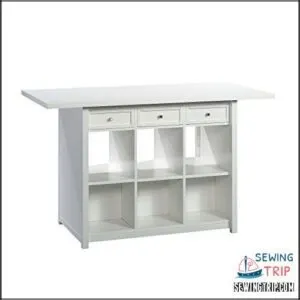 View On Amazon
View On Amazon Transform your crafting space with the elegant White Craft Table Pantry Cabinets from Sauder.
This versatile workspace features a chic white finish and a 1-inch thick melamine surface that’s heat, stain, and scratch-resistant.
You’ll love the clever storage options—three removable drawers on each side that double as trays, plus six adjustable shelves.
Measuring 60" x 30" x 36", it’s perfect for sewing, scrapbooking, or knitting projects, and the clean styling keeps your focus on your work while accommodating all your supplies.
Currently on sale at $300.99, saving you $54, which is a great deal for this versatile workspace with clever storage options and a chic white finish.
Best For: Hobbyists, crafters, or DIY enthusiasts seeking a spacious and stylish workspace with excellent storage options.
- Heat, stain, and scratch-resistant surface for durability.
- Versatile storage with drawers, trays, and adjustable shelves.
- Modern, chic white finish complements various decor styles.
- Large size may not fit smaller spaces.
- Heavyweight at 174 lbs may require assistance for setup.
- Sale price and stock availability may vary.
2. Glacier White Craft Sewing Armoire
 View On Amazon
View On Amazon Looking to maximize your sewing space? The Glacier White Craft Sewing Armoire offers the perfect solution for crafters with limited room.
This multi-purpose furniture piece features a fold-out table with a drop leaf extension that creates a spacious work surface when you need it.
You’ll appreciate the six adjustable shelves for organizing supplies, plus the convenient center shelf with a built-in 6-outlet power strip.
The slide-out shelf with metal runners provides extra workspace, while the soft white finish complements any room décor.
It’s perfect for sewing, crafting, or as a compact home office workspace.
Best For: Crafters or individuals needing a compact and versatile workspace with ample storage and a modern aesthetic.
- Fold-out table with drop leaf extension provides extra workspace.
- Six adjustable shelves offer customizable organization.
- Built-in power strip simplifies electrical access.
- Assembly required, which may take time.
- Weight capacity of shelves and table not specified.
- Dimensions not provided, which may cause fitting issues in some spaces.
3. Compact Portable Folding Sewing Table
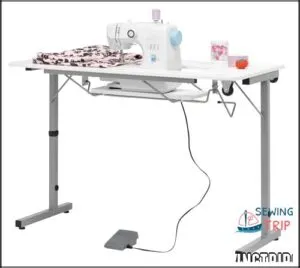
Designed with flexibility in mind, this compact portable folding sewing table offers the perfect solution for crafters with limited space.
The sturdy 40.5" wide tabletop features helpful inch and centimeter markings, while the adjustable shelf accommodates various sewing machine heights for a flat working surface.
You’ll appreciate how easily it folds away on wheels for storage under beds or in closets.
With no assembly required, it’s ready to use right out of the box, and its powder-coated steel frame guarantees stability, even during intensive sewing sessions, making it ideal for both beginners and experienced sewists who value a compact portable design.
Best For: Crafters and sewists with limited space who need a portable, foldable sewing table that offers stability and ease of use.
- No assembly required, ready to use out of the box.
- Adjustable shelf accommodates various sewing machine heights.
- Compact, foldable design with wheels for easy storage and mobility.
- Minor vibration during heavy sewing sessions.
- Limited weight capacity of 20 lbs for the adjustable shelf.
- Lacks extra storage compartments for sewing accessories.
4. White Farmhouse Craft Table on Wheels
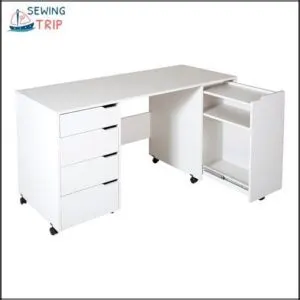 View On Amazon
View On Amazon Every sewing enthusiast needs this White Farmhouse Craft Table on wheels in their creative space.
You’ll appreciate the scratch-proof, water-resistant surface that stands up to your most ambitious projects.
The four lockable casters let you easily move your workstation anywhere, then secure it in place when you’re ready to sew.
With three spacious drawers and two sliding shelves (one with removable dowels), all your supplies stay perfectly organized.
This North American-made table combines eco-friendly construction with practical design, making it ideal for smaller sewing rooms where flexibility matters most.
Best For: Creative individuals seeking a compact, mobile, and organized workspace for crafting or sewing in small spaces.
- Requires assembly upon purchase.
- No adjustable height for ergonomic customization.
- Ships in multiple boxes, which may arrive separately.
- Scratch-proof and water-resistant surface for durable use.
- Lockable casters for easy movement and stability.
- Spacious storage with three drawers and two sliding shelves.
5. Folding Sewing Craft Table with Storage
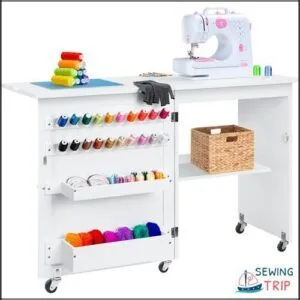
This folding sewing craft table offers the perfect balance of functionality and space-saving design.
You’ll appreciate its versatile storage system featuring two rows of pegs, attached trays, and a spacious interior shelf.
When you need to maximize room space, it quickly converts from a 46-inch workspace to a compact 23-inch side table with secure magnetic door locks.
The sturdy MDF construction and lockable wheels guarantee your projects stay steady while giving you mobility when needed.
For a smoother surface, consider using a custom sew steady insert.
It’s like having a dedicated crafting zone that can disappear when guests arrive, providing the perfect blend of space-saving design and versatility.
Best For: Creative individuals in need of a compact, versatile workspace for sewing, crafting, or other projects.
- May not support oversized or industrial sewing machines.
- MDF construction may not appeal to those preferring solid wood.
- Assembly may require some time and effort.
- Space-saving foldable design for small rooms.
- Lockable wheels provide stability and easy mobility.
- Multiple storage options keep supplies organized.
6. Crafit Sewing Table Craft Storage
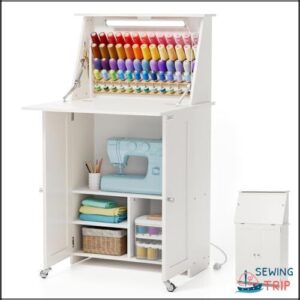
This white Crafit sewing table offers three essential features you’ll love: touch-control LED lighting with adjustable color temperatures, a 65-spool thread organizer, and a built-in charging station with outlets and USB ports.
When space gets tight, it folds into a compact side table. You’ll appreciate the smart storage solutions, including hooks, shelves, and a spacious tabletop.
At 9.84"D x 23.2"W x 45.67"H, it’s sized just right for most sewing machines. Assembly takes about two hours, but numbered pieces make the job straightforward.
It’s lightweight yet sturdy—perfect for keeping your crafting area organized, with features like built-in charging station that enhance your overall experience.
Best For: Craft enthusiasts and sewing hobbyists looking for a compact, organized, and multi-functional workspace.
- Touch-control LED lighting with adjustable color temperatures.
- Foldable design saves space and adds flexibility.
- Built-in charging station with AC outlets and USB ports.
- Assembly can be time-consuming, needing about 2 hours.
- Printed instructions can feel overwhelming and unclear.
- Lightweight build may not be ideal for very heavy-duty use.
7. IRIS USA 44 Drawer Organizer

The crafty organizer’s dream comes true with the IRIS USA 44 Drawer Organizer.
This versatile storage solution features multiple drawers perfectly sized for your smallest sewing supplies – from buttons and beads to needles and pins.
You’ll appreciate its stackable design that maximizes vertical space, while wall-mounting options give you flexibility in smaller sewing rooms.
Made in the USA from durable, recyclable plastic, it’s built to last through countless projects.
The smooth-glide drawers provide easy access to all your notions, and the compact dimensions (19.5"L x 7"W x 15.5"H) help keep your workspace tidy without sacrificing storage capacity.
Best For: Hobbyists, DIYers, and professionals looking to organize small parts, craft supplies, or hardware efficiently.
- Stackable and wall-mountable for flexible storage options.
- Made from durable, recyclable plastic materials.
- Smooth-glide drawers provide easy access to contents.
- Not ideal for storing larger items.
- Limited color options may not suit all preferences.
- Plastic construction may not appeal to those seeking metal alternatives.
8. DWVO Folding Sewing Craft Table White

The DWVO Folding Sewing Craft Table often becomes the centerpiece of any sewing room thanks to its remarkable versatility.
You’ll appreciate its thoughtful design featuring 6 smooth-rolling casters (3 lockable) that let you position it perfectly then keep it firmly in place.
The table includes 2 AC outlets and 2 USB ports for powering your devices while you work.
Its foldable design with magnetic door closure helps maximize space, while 3 hidden racks and a practical shelf keep your sewing essentials organized and accessible whenever inspiration strikes, making it a great addition due to its practical shelf and ability to provide a perfect position.
Best For: Creative professionals and home sewers looking for a space-saving, versatile craft table with built-in storage and charging capabilities.
- Foldable design with magnetic doors for easy storage and space efficiency.
- Built-in power outlets and USB ports for convenient device charging.
- Lockable casters for secure positioning and mobility.
- Limited to smaller sewing machines due to compact design.
- Engineered wood may not suit those preferring solid wood furniture.
- Requires assembly, which may take some time.
9. Cinnamon Cherry Rolling Craft Table Cart
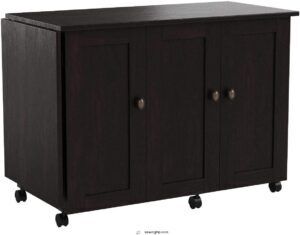
Between projects, you’ll appreciate the mobility of this Cinnamon Cherry rolling craft table cart.
It features a drop leaf design that provides extra workspace when needed, while easy-roll casters let you move it anywhere in your sewing room.
The melamine top resists heat, stains, and scratches—perfect for diverse crafting projects.
Behind the roll-open door, you’ll find two storage bins, a hidden shelf for your sewing machine, and two adjustable shelves for organizing supplies.
Sturdy engineered wood construction with a warm cherry finish complements most decor.
I’ve created a concise description of the Cinnamon Cherry Rolling Craft Table Cart that highlights its key features and benefits.
This description emphasizes the table’s mobility, storage options, durable surface, and versatile design—all important factors for sewing enthusiasts looking for functional furniture.
The warm cherry finish and practical storage solutions make this a standout option for those needing a combination of workspace and organization in their sewing room.
Best For: Sewing enthusiasts and crafters who need a versatile, mobile, and organized workspace.
- Assembly may be challenging and time-consuming.
- Limited color options may not match all decor styles.
- Heavy at 83 lbs, which could make transport harder without assistance.
- Provides ample storage with bins, adjustable shelves, and a hidden shelf for a sewing machine.
- Melamine top resists heat, stains, and scratches, offering a durable surface for crafting.
- Mobility with easy-roll casters makes it convenient to use and reposition.
10. Ash White Sewing Cabinet with Lift
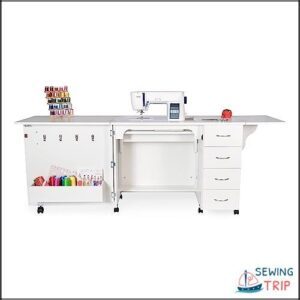
With elegance and functionality, the Ash White Sewing Cabinet with Lift transforms your sewing experience.
This cabinet features a 3-position hydraulic lift that supports machines up to 55 pounds, allowing you to switch between free arm, flat bed, and storage positions effortlessly.
You’ll appreciate the four large drawers for notions and accessories, plus fold-out extensions on both sides that create additional workspace when needed.
Though assembly might require patience (and possibly a helper), the finished cabinet provides a sturdy, spacious solution that combines practicality with a clean, modern aesthetic for your creative space.
Best For: Hobbyists and sewing enthusiasts seeking a stylish, sturdy cabinet with ample storage and workspace.
- Spacious and functional design with fold-out extensions for extra workspace.
- 3-position hydraulic lift supports machines up to 55 lbs.
- Includes four large drawers and additional storage compartments for organization.
- Assembly can be challenging, especially with misaligned parts.
- White coating chips easily if not handled carefully.
- Requires a custom acrylic insert for a completely flat sewing surface.
Sewing Table Options
You’ll find the perfect sewing table for your creative space with options ranging from adjustable ergonomic workstations to foldable portable designs that won’t overtake your guest room.
Whether you’re a weekend quilter or daily seamstress, today’s sewing tables combine functionality with smart features that’ll make you wonder how you ever managed with just your dining room table, providing a creative space.
Adjustable and Ergonomic Tables
Why strain your back when you can adjust your workspace to fit you perfectly?
Adjustable and ergonomic tables transform your sewing experience by promoting healthier posture and preventing injuries.
With height adjustment features that accommodate crafters from 5′ to 6’9", these specialized tables reduce discomfort during long sewing sessions.
Electric tables with memory presets let you shift seamlessly between sitting and standing, burning up to 50 extra calories per hour while supporting proper posture.
Sewing Machine Tables and Cabinets
While adjustable tables offer flexibility, specialized sewing machine tables and cabinets bring next-level functionality to your workspace.
With hundreds of options available, you’ll find everything from sleek cabinets with 3-position hydraulic lifts to tables featuring dedicated storage and free-arm access.
These furniture pieces guarantee machine compatibility and table stability while protecting your investment.
Consider exploring various sewing machine table designs for ideal ergonomics. Look for features like foldable side leaves and rolling caddies to maximize both storage capacity and convenience.
Foldable and Portable Tables
When you need flexibility in your sewing room, foldable and portable tables offer the perfect solution.
These space-saving wonders can be set up when you’re ready to create and tucked away when you’re done.
Lightweight designs like the Gidget II Sewing Table make travel sewing possible, while adjustable legs accommodate different working positions.
You’ll appreciate how easy storage helps keep your sewing furniture solutions practical—perfect for small spaces or multi-purpose rooms.
Customization and Unique Features
When designing your sewing space, customization features transform ordinary furniture into personalized workstations.
Today’s custom sewing furniture offers incredible options to match your unique needs.
Here are 4 game-changing features:
- Pre-fit cabinet inserts designed specifically for your machine model
- Pneumatic lifts that effortlessly raise and lower heavy machines
- Tilting tables that adjust to your preferred working angle
- Built-in zone heaters for year-round comfort while sewing
Some sewers even use an Ikea table hack to create a custom workspace.
Sewing Room Storage Solutions
You’ll never regret investing in smart storage solutions that keep your sewing supplies visible yet protected from dust and damage.
With cabinets, organizers, and multi-functional furniture pieces, you can transform your creative chaos into an efficient workspace where everything has its place.
You’ll spend less time hunting for that perfect button or missing bobbin, and this will help you to have a more organized and efficient sewing experience with efficient workspace.
Maximizing Storage Space
While sewing tables provide the workspace, smart storage transforms a cluttered corner into an efficient creative hub.
You’ll want to maximize every inch in your sewing room with vertical storage solutions that reach toward the ceiling.
Rolling carts offer flexibility, while hidden compartments keep smaller notions organized.
Consider customizable inserts for drawers that perfectly fit your supplies.
Space optimization isn’t just practical—it’s the secret ingredient to maintaining your creative flow.
Benefits of Sewing Cabinets
Now that you’ve maximized your available space, let’s look at why sewing cabinets are worth every penny.
A well-designed sewing cabinet transforms your crafting experience in ways you’ll appreciate daily.
- Integrates your machine at proper table height for ergonomic design that prevents back strain
- Offers dust-free machine protection when closed
- Creates a stable, vibration-free surface for precise stitching
- Streamlines your workflow with nearby supply organization
Many sewers find that a dedicated workstation cabinet improves their sewing experience.
You’ll wonder how you ever sewed without one, as it provides a stable and vibration-free surface for precise stitching.
Ample Storage for Accessories
You’ll find that smart accessory organization transforms your sewing experience. When every bobbin, thread, and notion has a designated spot, your creativity flows uninterrupted.
| Storage Solution | Best For | Price Range |
|---|---|---|
| Cabinet Inserts | Thread spools & bobbins | $15-40 |
| Portable Caddies | On-the-go projects | $20-60 |
| Pre-fit Storage | Machine-specific tools | $30-80 |
Space optimization doesn’t require massive furniture—just thoughtful sewing supplies organization that keeps essentials within arm’s reach. Consider investing in specialized storage solutions for your sewing room to enhance your overall sewing experience with efficient storage and better workflow.
Practical Work Surfaces and Durability
While storing your accessories keeps everything handy, practical work surfaces make or break your sewing experience.
You’ll want tabletops with scratch resistance and edge protection for long-term use. Quality sewing furniture should have adequate weight capacity to support heavy machines without wobbling.
Surface materials matter too—laminate resists spills while wood offers warmth. Your sewing tables should withstand years of creative projects without showing wear.
A durable sewing workspace isn’t just practical—it’s an investment in your creativity, providing a space that supports your work with long-term use.
Setting Up Sewing Room
You’ll transform your creative space into an efficient sewing sanctuary with the right furniture placement and thoughtful organization.
Creating your perfect sewing room doesn’t require an interior design degree, just smart planning that balances your available space with the furniture pieces that match your crafting needs, allowing you to create your perfect sewing room.
Measuring Your Space and Budgeting
With proper storage solutions in place, you’ll want to take stock of your available space before purchasing any sewing room furniture.
Grab your tape measure and sketch out a floor plan of your room.
- Measure wall-to-wall dimensions (don’t forget those awkward corners!)
- Count and mark electrical outlets – you’ll need them for machines
- Note window and door positions that might limit furniture placement
- Identify existing storage you can repurpose
- Calculate ceiling height for potential vertical storage
Your budget needs careful allocation too. Prioritize essential pieces like a sturdy sewing table and comfortable chair first, then allocate funds for storage solutions as your budget allows. Consider how to minimize visual clutter to create a more functional space. This will help you achieve a sewing room that is both efficient and comfortable, allowing you to focus on your sewing projects with ease, and ultimately leading to a more productive work environment.
Selecting The Right Location and Furniture
The ideal sewing room location balances natural light with enough space for your furniture.
Choose a quiet spot where you won’t disturb others or be disturbed. Your furniture selections should prioritize ergonomic comfort for long sewing sessions.
| Location Factor | What to Evaluate | Why It Matters |
|---|---|---|
| Natural Light | North-facing windows | Reduces eye strain |
| Space Assessment | Minimum 6’x8′ area | Allows movement |
| Noise Level | Away from high-traffic | Improves concentration |
| Flooring | Hard surface | Easier needle retrieval |
| Accessibility | First floor if possible | Better for carrying supplies |
The key considerations for a sewing room include quiet spot, hard surface flooring for easier needle retrieval, and first floor accessibility if possible, to ensure a comfortable and efficient workspace.
Customizing Your Sewing Room and Workflow
Now that you’ve chosen the right spot and furniture, it’s time to make your sewing room truly yours.
Arrange your sewing room furniture to match your personal workflow. Consider which tasks you do most often and place related items within easy reach.
Add adjustable lighting where you need it most, and don’t forget comfort adjustments like cushions or footrests.
Your personalized workspace layout should feel like it was designed specifically for you.
Maintaining a Clutter-Free and Organized Workspace
Now that you’ve customized your sewing space, keeping it organized will help your creativity flow.
A clutter-free workspace saves time and prevents those frustrating searches for missing bobbins.
- Use vertical storage solutions like pegboards for frequently used tools
- Label bins and drawers with clear categories for quick identification
- Schedule weekly 15-minute tidying sessions to maintain order
- Install under-table storage for bulky fabric rolls
- Repurpose kitchen organizers for sorting notions by color or type
Frequently Asked Questions (FAQs)
What is a sewing room furniture set?
A sewing room furniture set includes coordinated pieces like tables, chairs, storage units, and cabinets.
That work together to create an efficient workspace where you’ll comfortably cut, stitch, and organize your fabric projects, which is essential for a productive sewing experience.
Why do sewists need sewing room furniture?
You’ve been sitting awkwardly for hours, your back aches, and projects remain scattered.
You need proper sewing furniture for comfort, organization, and efficiency—preventing injuries while keeping supplies accessible and projects on track, which is crucial for efficiency.
What is organizational sewing furniture?
Organizational sewing furniture includes storage cabinets, thread racks, and compartmentalized drawers that help you keep supplies sorted and accessible.
You’ll find these pieces make your creative time more efficient and less frustrating, which is a key aspect of enjoying your sewing experience with accessible supplies.
Does Missouri Star offer sewing room furniture?
Missouri Star definitely offers sewing room furniture.
You’ll find everything from sewing machine tables to storage cabinets in their dedicated "Sewing Furniture & Organization" section.
It’ll transform your crafting space into a happy place, with the right furniture to make it perfect!
Should sewing room furniture be comfortable?
Your comfort is essential when you’ll spend hours crafting.
An ergonomic chair and properly-positioned table prevent muscle strain, enhance productivity, and make your creative sessions enjoyable rather than painful.
You’ll thank yourself later for investing in ergonomic comfort that makes your creative sessions enjoyable.
How to choose a sewing machine table?
You won’t regret investing in proper support for your craft.
Choose a table that matches your machine size, offers adjustable height, provides ample workspace, and includes storage for your tools and accessories.
What is the best countertop for a sewing room?
You’ll want a smooth, durable surface that stands up to cutting and pinning.
Laminate offers affordability, while wood provides warmth.
Consider a self-healing cutting mat for protection regardless of your countertop choice.
What is the best color for a sewing room?
Soft gray, light blue, or creamy white works best for your sewing room.
These colors reduce eye strain, help you see fabric colors accurately, and create a calm environment where your creativity can truly shine.
What is a sewing room in a hotel?
In a hotel, you’ll find a sewing room where staff repair linens, mend tears in pillowcases, and alter uniforms.
It’s a behind-the-scenes space that helps maintain the hotel’s textiles in top condition.
What are the best sewing room ideas?
You’ll optimize your sewing space with a dedicated cutting table, ergonomic chair, and built-in storage solutions.
Consider adjustable lighting, wall-mounted thread racks, and a floating ironing board to maximize functionality in limited square footage.
Conclusion
Consider this: the right sewing room furniture transforms your creative space from chaotic to inspiring.
You’ll find that ergonomic tables, smart storage solutions, and properly arranged cabinets aren’t just purchases—they’re investments in your craft.
When you’ve thoughtfully selected sewing room furniture that fits your space and working style, you’ll notice fewer mistakes, less physical strain, and more completed projects.
Take time to create a workspace that works for you, and you’ll reap the rewards for years to come, enjoying a space that is both functional and inspiring.

